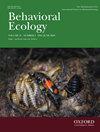Anthropogenic light impacts life-history traits and induces a trade-off in female field crickets
IF 2.2
3区 环境科学与生态学
Q2 BEHAVIORAL SCIENCES
引用次数: 0
Abstract
Human-induced rapid environmental changes introduce animals to novel selection pressures that may impact how individuals allocate resources into life-history traits. One pervasive anthropogenic stressor, artificial light at night (ALAN), extends into remote areas and masks the day:night cycles to which animals are attuned. Here we ask how animals use this environmental input to dictate their investment in survival and reproductive traits and whether they must trade off investment in these traits in female Gryllus veletis field crickets. Using the second generation of field-collected individuals from a location absent from ALAN, we reared females from the antepenultimate instar through adulthood in either a control environment or one with ALAN. We then measured their investment in survival through two aspects of immunity, encapsulation and lysozyme activity, and their reproductive investment as the number of eggs within a female. We found that ALAN reduced one aspect of immunity, lysozyme activity, and reproductive investment. Further, there was a negative trade-off in investment in encapsulation and reproduction, an investment cost that was not present in females reared without ALAN. Our results suggest a two-fold cost of ALAN on females: one on investment in individual traits and another on a trade-off between them. These maladaptive responses to ALAN could substantially impact natural populations in the short term, and whether populations could respond in the long term remains an open question.人为光照影响雌性田园蟋蟀的生活史特征并诱导其权衡取舍
人类引起的快速环境变化使动物面临新的选择压力,这些压力可能会影响个体如何将资源分配到生命史特征上。一种普遍存在的人为压力--夜间人造光(ALAN)--延伸到偏远地区,掩盖了动物所适应的昼夜周期。在这里,我们想知道动物如何利用这种环境输入来决定它们在生存和繁殖特征上的投资,以及它们是否必须在雌性田野蟋蟀(Gryllus veletis field crickles)的这些特征投资上进行权衡。我们利用从一个没有ALAN的地方采集的第二代田间个体,在对照环境或有ALAN的环境中饲养雌性蟋蟀从初生到成年。然后,我们通过免疫力的两个方面--包囊和溶菌酶活性--测量了它们的生存投资,并通过雌虫体内的卵数测量了它们的生殖投资。我们发现,ALAN降低了免疫力的一个方面,即溶菌酶活性和生殖投资。此外,在封装和繁殖方面的投资出现了负的权衡,这种投资成本在未饲养 ALAN 的雌性中并不存在。我们的研究结果表明,ALAN对雌性动物造成了两方面的成本:一方面是对个体性状的投资,另一方面是对它们之间的权衡。这些对ALAN的不适应反应可能会在短期内对自然种群产生重大影响,而种群是否能在长期内做出反应仍是一个悬而未决的问题。
本文章由计算机程序翻译,如有差异,请以英文原文为准。
求助全文
约1分钟内获得全文
求助全文
来源期刊

Behavioral Ecology
环境科学-动物学
CiteScore
5.20
自引率
8.30%
发文量
93
审稿时长
3.0 months
期刊介绍:
Studies on the whole range of behaving organisms, including plants, invertebrates, vertebrates, and humans, are included.
Behavioral Ecology construes the field in its broadest sense to include 1) the use of ecological and evolutionary processes to explain the occurrence and adaptive significance of behavior patterns; 2) the use of behavioral processes to predict ecological patterns, and 3) empirical, comparative analyses relating behavior to the environment in which it occurs.
 求助内容:
求助内容: 应助结果提醒方式:
应助结果提醒方式:


